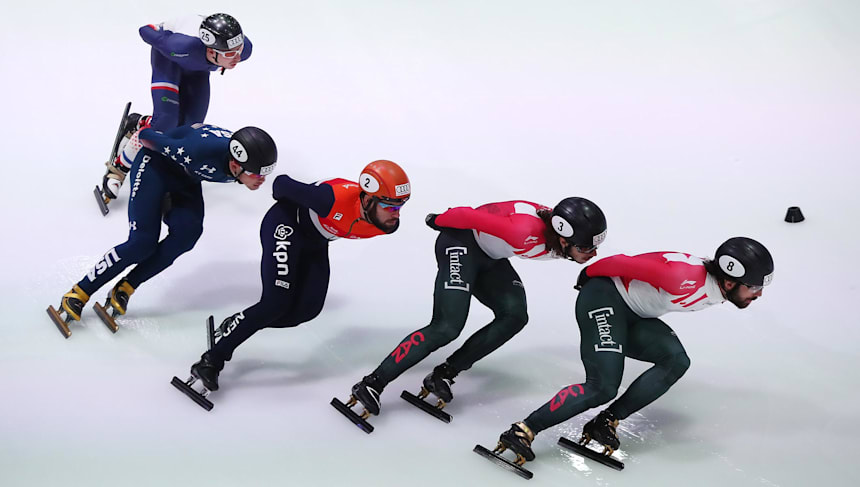Samuel Girard’s Guide to Short Track at PyeongChang 2018
There is “no sport like short track”, according to the triple World Championship silver medallist, Samuel Girard. With Lycra-clad competitors flying round the oval, inches from the ice at speeds of up to 45kmh, the Canadian has a point.
“Nothing compares to it,” Girard says. “You really have to see it to understand the speed involved, to see the ice crack up, to understand the passing strategy, the way people have a fraction of a second to make a move.”
The lowdown
The short track programme at the PyeongChang 2018 Olympic Winter Games comprises the 500m (four-and-a-half laps), the 1,000m (nine laps) and the 1,500m (13.5 laps) for men and women; a 3,000m relay for women (teams of four skaters competing over 27 laps); and a 5,000m relay for men (teams of four battling over 45 laps).
Speed, strength and stamina are prerequisites, with most elite skaters competing across the four events per gender. Add endless tight turns and team and individual tactics to the mix and you can see why many people pinpoint short track as one of the most dynamic winter sports on the Olympic programme.
You really have to see it to understand the speed involved, to see the ice crack up, to understand the passing strategy, the way people have a fraction of a second to make a move Samuel Girard - Samuel Girard
“The passing and the strategy are what I focus on,” Girard explains. “Guys have a fraction of a second to make a pass. In the 500m you only have 40 seconds to do your moves; it’s really quick. You can’t lose your focus or awareness of people behind you.”
“You have to be compact. If you are too upright your centre of gravity is too far from the ice,” Girard explains. “You need to be low and really compact.
“It allows you to turn and to control the ice breaking under you,” the Canadian adds. “The ice breaks under the blades from the intense pressure we are putting on it going round the curve, and you have to control this. If the ice is breaking under your feet but you are compact, you can control it. If you are too high, your feet will be in the wrong place and for sure you will fall.”

500m
Currently ranked third in the overall 2017/18 ISU World Cup 500m standings, Girard will be a major medal threat in PyeongChang in the 500m.
“For sure, speed and acceleration are really important, but I think instinct is key. When you feel something, maybe that you have to pass or you know the person in front of you is about to make a mistake and you take your opportunity, that is what makes a great 500m skater,” the 21-year-old continues.
“The easiest way to win a 500m is to be at the front from the start. It is easier to block a person than to try to pass someone.”
1,000m
Girard has already won a major medal at this distance in Korea, taking silver at the 2016 World Championships in Seoul.
“I really love this distance because it’s a mix. It’s not too long but not too short; you have time to change and recover,” he says. “You have a moment to react to things. I love the stress of finding the right moment to attack. It is all about controlling the pace and the strategy.”

1,500m
“Again, strategy is really important,” Girard explains. “You do have the chance to recover from a mistake, which is really helpful. And it’s important to manage your energy. If there is time between the rounds then some guys will go fast in the heats and then it’s tough on the legs.”
The nature of the 13.5-lap race and the fact that the vast majority of the world’s very best skaters compete across the four events mean that it is particularly hard to pick a favourite in the 1,500m.
“A lot of people come into contention because you have that time to make a mistake and recover,” Girard confirms. “All of the best skaters are pretty complete athletes, so they have the speed, which is really useful.”
5,000m relay
“It is one of my favourite events,” Girard smiles. “You have to think about so many things – the strategy; the track is different because the ice gets really bad by the end; and you have to manage your energy, do the handovers. There is a lot going round your head.”

The Canadian quartet, consisting of Girard, three-time Olympic champion Charles Hamelin, Pascal Dio and Charle Cournoyer, recovered spectacularly from a poor 2016/17 to light up the four ISU World Cups this season. The team emerged with two golds and a bronze, and Girard is pretty sure he knows why.
“Last year, we didn’t have a great year, so we trained a lot, talked a lot about any issues on the team,” he explained. “Now we are confident among each other, which really helps on the ice. We are not stressed; we know what we have to do.
“We are also trying a lot of different strategies, so we have more cards to play at the Olympics. We want to be unpredictable and surprise the other teams.”